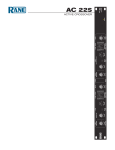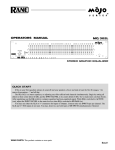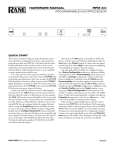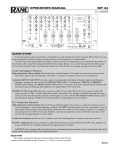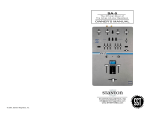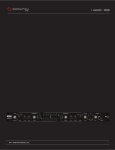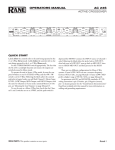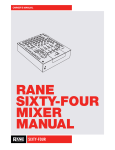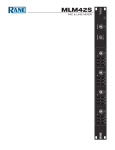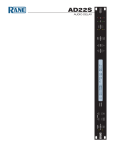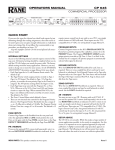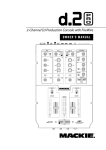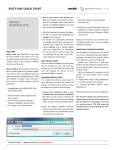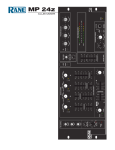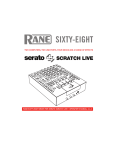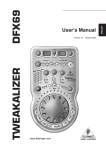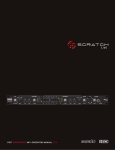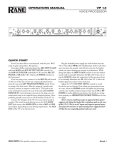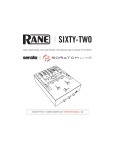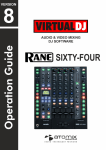Download Rane TTM 56S DJ Equipment User Manual
Transcript
OPERATORS MANUAL TTM 56S PERFORMANCE MIXER Quick Start Congratulations! You are the proud owner of an exceptional performance instrument. Experienced turntablists will find the TTM 56S comfortable and familiar. The TTM 56S has many unique features which are mastered quicker if you read the manual. Right! We know you can’t resist jumping right in, but please read at least this portion of the manual. It will help you get a good start. About the faders: The program faders and crossfader are magnetic, non-contact faders. This means No travel noise – No bleed – Ever! The electrical performance of the faders is unaffected by use. Old habits are hard to break, but you really don’t have to mess with these faders. The magnetic faders in this mixer are very different from what you are used to. Be sure and read the Q and A section on page Manual-6. Special Features: • KILL switches behave like transform controls, to quickly cut a signal in or out. Be sure these switches are up to get sound! • Separate CONTOUR controls for each fader and the crossfader allow continuous adjustment from smooth blend to fast cut. • The CHANNEL SWAP switch allows the left-hand or righthand fader to control PGM 1 or PGM 2. • Auxiliary Inputs and Outputs, with independent level controls, give session mixing ability. AUX Inputs may be used for a drum machine, keyboard, etc. AUX Input comes in after the Crossfader and after the FlexFX loop. AUX Outputs may be used for recording, booth monitoring, or a second zone. AUX Output is the same mix as the Master. • FlexFX™ allow individual assignment of PGM 1, PGM 2 or both to the effects loop. The effects loop is post-fader. You get great results when using the program faders or crossfader with reverb or other delay effects. For instance, reverb and echo tails are still heard after the fader is off. The WET/DRY pan lets you control how much of the effect is in the mix. • Three-band Accelerated-Slope™ EQ allows full cut of each band. The EQ engage switches lets you A/B compare or quickly transform the EQ effect. • Two 10-segment meters provide Dual-Mono-Cue or Stereo-Master operation. • Yes, we included a power switch on the rear. The flexibility of the TTM 56S can result in some initial confusion. The CHANNEL SWAP switch, KILL switches, REVERSE switches, Faders and Crossfader are all different ways to cut the signal. We recommend trying one thing at a time. Check that the KILL switches are ON (up position). Make sure the CHANNEL SWAP switch (and its yellow LED) is off . Start by changing the Contour of each fader, one at a time. See the diagrams on page Manual-5 to understand the fader responses under different settings, with REVERSE on and off. Once you understand the controls, start creating! WEAR PARTS: This product contains no wear parts. Manual-1 Rear Panel Hook-up TTM 56S COMMERCIAL AUDIO EQUIPMENT 24TJ MADE IN U.S.A. RANE CORP. U.S. PATENT 6,813,361 POWER R ACN 001 345 482 MASTER L PHONO GROUNDS FlexFX OUTPUTS AUX OUT PGM 2 L IN 4 L R Power The TTM 56S features an internal universal switching power supply that operates on any AC mains 100 to 240 VAC, 50 or 60 Hz (most places in the world). All that is required when traveling is the appropriate IEC line cord available in each country. The universal supply is a major plus for the traveling DJ. The POWER switch is just above the power connector. You know what to do with this, but leave it off until everything is connected. Inputs PGM 1 and PGM 2 each have two inputs, each assignable PHONO or LINE. For a turntable input with RIAA compensation, push the corresponding switch up to PHONO. For all other sources such as CD or MP3 players, push the corresponding switch down to LINE. PHONO GROUNDS provide independent ground connect points for turntables. It is very important that each turntable have a very good ground connection to one of these terminals. The thumbscrews will come off if they are over-rotated, so be careful not to spin them off and lose them. AUX IN may be used with a drum machine, groovebox, sampler, or another mixer’s output for session mix. This Input is mixed after the Crossfader and FlexFX loop. MIC INPUT is a balanced input specifically designed for a dynamic mic (a condenser mic will not work). Manual-2 L 1 L PHONO 4321 R OUT R IN UNBALANCED 4 Effects Loops R 3 O N R 2 1 1 2 3 EFFECTS 4 4321 LINE TIP = SEND RING = RTN Outputs MIC EFFECTS insert jack is unbalanced. It is wired for ¼" TRS, meaning Tip=Send, Ring=Return and the Shield or Sleeve. This is an independent Effects Loop for the Mic. There is no engage switch, so the Mic signal is always processed when you have a plug inserted and an effects box connected. If you are connecting to an effects processor with a Send/Return (sometimes called Insert) jack, a single TRS cable will work. If your effects processor has separate Send and Receive jacks, you need a “Y” cable. You can buy a Send/ Return cable from your local music store, or you can make one of your own as shown below. FlexFX EFFECTS jacks are unbalanced mono ¼" TS (Tip and Sleeve). This stereo loop is used for output to (send) and input from (return) an effects processor. The SEND jacks provide the output to your effects processor. The RETURN jacks provide input for the signal returning from your effects processor. If you have an effects device with a single ¼" TRS, tip=send, ring=return jack, you need a “Y” cable, as shown below. + AUX OUT may be used for recording, booth monitoring, a second playback zone, or connecting another mixer for session mix. AUX OUT is the same signal as the Master Mix with its own Level control. MASTER OUT includes two sets of stereo outputs: The ¼" TRS jacks provide balanced (Tip-Ring-Sleeve) output. Use this balanced output whenever driving equipment with a balanced input, or when running distances greater than 10 feet (3 meters). Never use a mono ¼" Tip/Sleeve (no ring) plug in this jack. Use the RCA unbalanced outputs for shorter runs connecting to unbalanced devices. See the RaneNote “Sound System Interconnection” if you need to convert between balanced and unbalanced or run long distances. 1-CONDUCTOR SHIELDED CABLE + SEND SHIELD T = SEND R = RETURN S = SHIELD BALANCED 2 SEND R 100-240V 50/60 Hz 20 WATTS PGM 1 3 L RETURN MIC BALANCED + 1-CONDUCTOR SHIELDED CABLE SHIELD + SHIELD Send/Return Cable Wiring (Insert Cable) RETURN Mic Section MIC LEVEL sets the gain of the Mic Input. The range is off to +44 dB. There is no engage switch, so set the Mic Level to zero (0) when you aren't using it. The Mic Input minimum gain is 26 dB, so a line-level mic source (such as a wireless receiver) must be padded. PGM 1 4 10 MIC LEVEL 8 0 10 3 8 0 L +6 PAN SOURCE 10 GAIN L R PAN R OFF HIGH 10 +6 OFF OUT OUT OFF FlexFX +6 PGM 2 inputs are sent to the right side of the crossfader. (with the Fader 2 Reverse switch out and LED off ) SOURCE switches select which inputs are assigned to each of the Programs. PGM 1 can switch between inputs 1 and 2. PGM 2 can switch between inputs 3 and 4. GAIN controls adjust the signal level before it gets to the Faders. Set the Gain controls to indicate an average signal level of +4 on the meter with the program faders set to maximum. Don't use the Gain controls to set the output level...use the Main Level control to set the output level. This is a very simple thing, yet makes a huge difference in mixer performance. 10 4 6 0 10 8 8 OFF AUX IN MASTER CUE +6 LOW OUT OUT DRY WET PGM 1 PGM 2 CUE SLOW KILL FAST SLOW REVERSE FAST CROSSFADE CONTOUR EQ switches engage the 3-band tone MONO PGM1 / PGM2 STEREO HOUSE controls. EQ switches may be used in conjunction with the High, Mid and Low controls as “kill” switches by turning any or all of them Off. Set the rotary controls and flip the switch. OL +8 +4 +2 0 –2 –4 –8 PGM 1 inputs are sent to the left side of the crossfader. (with the Fader 1 Reverse switch out and LED off ) 0 PGM 2 LOW FADER 1 CONTOUR Program Sections 6 PHONES PGM 1 8 CHANNEL SWAP Combined response of the Mic tone controls 4 2 +6 MID KILL 50k 10 AUX OUT MIC LOW 0 0 8 EQ MID 6 6 2 +6 +12 4 4 2 IN IN MIC HIGH OFF AUDIO PRECISION AMPL(dBr) vs FREQ(Hz) 20 18 16 14 12 Low +12, High +12 10 8 6 4 2 Low 0, High 0 0 -2 -4 -6 -8 Low -12, High -12 -10 10k 4 MAIN HIGH -12 OUTPUT LEVELS 6 2 GAIN +12 2 1k 4 OL OFF -12 2 SOURCE 8 0 2 6 EQ MIC HIGH and LOW tone controls provide as much as 12 dB of boost or 12 dB of cut. These controls have no effect when the controls are set to their center detent (12 o'clock). 100 1 6 2 The OL indicator lights 6 dB before clipping. Adjust the Mic Level so the OL indicator flashes only when you really shout into the mic. -12 -14 -16 -18 -20 20 PGM 2 4 HIGH tone controls affect frequencies –16 above 4 kHz. The range of control is –24 +6 dB to Off (full kill). The center detent position leaves this filter inactive. This filter is just above the vocal range, A and can make small tonal changes, or eliminate high frequency signals. MID tone controls affect frequencies from 300 Hz to 4 kHz (vocal midrange). The range of control is +6 dB to Off (full kill). The center detent position leaves this filter inactive. Use for small tonal changes or to cut midrange signals. LOW tone controls affect frequencies below 300 Hz. The range is +6 dB to Off (full kill). The center detent position leaves the filter inactive. These filters influence signals below the vocal range. Use to adjust or eliminate bass beats. PAN controls adjust the Left and Right balance of PGM 1 and PGM 2. SLOW REVERSE FAST FADER 2 CONTOUR REVERSE KILL switches provide quick program mute, much like the Transform switches on the previous TTM 56. The signal is ON in the up postion, the straight out position Kills the signal. Aux Input AUX IN adds another line-level input to the mix. This input comes in after the Crossfader and FlexFX Loop. FlexFX Loop B TTM 56S PERFORMANCE MIXER FlexFX switches send PGM 1, PGM 2 or both to the stereo effects loop. The effects loop is post-fader and postcrossfader. You get great results when using the program faders or crossfader with reverb or other delay effects. The effects loop provides separate stereo send and return jacks. The green indicator lights when FlexFX is engaged for either Program. WET/DRY pan control lets you set the amount of effect in the mix. DRY equals no effect, WET gives maximum effect. Output Levels MASTER control sets the level for both the unbalanced and balanced Master Outputs. AUX OUTPUT control sets the level going to the Auxiliary Outputs. Manual-3 Faders The program faders and crossfader are magnetic, non-contact faders. This means No travel noise or bleed ! The electrical performance of the faders is unaffected by use. The program faders and crossfader each have their own Contour and Reverse (hamster) controls. Magnetic faders are very different from what you are used to. Read Maintaining Magnetic Faders on pages Manual 8-9. CHANNEL SWAP switch allows the left-hand or right-hand Fader to alternately control PGM 1 or PGM 2. (Don't confuse with the REVERSE switches, see below.) CONTOUR controls allow smooth, continuous adjustment of contour. The range of control is from SLOW blend to FAST cut, adjustable independently for each fader and the crossfader. See the illustrations on the next page. REVERSE switches change the direction of the faders. When a Reverse switch is engaged on a PGM fader, up is down and down is up (hamster). When the Reverse switch is engaged on the Crossfader, PGM 1 goes to the B side and PGM 2 goes to the A side. Meters Meters provide switchable true stereo Master Mix or dual-mono PGM1 / PGM2 indication of Pre-Program fader signal levels. Ten-segment resolution is provided with a one second, peak hold. Use the meter to set the GAIN controls. With the program fader set to maximum, the input GAIN should be set to indicate an average level of about +4 dB. Headphone Cueing • The headphone output of the TTM 56S delivers very high volume. PHONES Level control sets the output level of the headphone amplifier. • To avoid pain, never put headphones on your head before plugging them in. MASTER / CUE switch is used to select the headphone monitor source: • Always start with the PHONES Level turned down, and then turn it up. Use MASTER (out) to rehearse your performance. This signal is the same as the Master Out, but is not affected by the Master Level control. • Because of the high current and low output impedance, never short one side to ground, or short left and right together as is possible with mono cup headphones. Use CUE (in) to monitor the Program Input signal before fadingPGM in.1This signal is not affected by the Program 1 2 Faders or Crossfader. Because the Effects SOURCE GAIN Loop is after the Fader, you will not hear MIC LEVEL OL effects in the Cue. 4 4 2 6 2 0 4 2 10 L +6 L R HIGH CUE slider Pans between PGM 1PANand PGMMIC 2 HIGH in the headphones when the EQ CUE switch is depressed. When the MID control has no switch is released, this effect.MIC LOW -12 +12 4 +6 R OFF 2 8 OFF +6 0 10 4 6 0 10 4 6 0 10 8 HIGH 8 AUX OUT EQ OFF OUT 2 +6 MID 8 PHONES PGM 1 10 6 2 +6 +12 6 4 2 IN OUT The headphone ampLOW in the TTM 56S has a high AUX IN power output (unlike most you have used before). There are notable differences… 0 10 PAN IN OFF -12 8 0 10 OFF OUTPUT 6 LEVELS • Low power3 headphone stages typically 4 use large resistors on their outputs, SOURCE GAIN which allow shorting, but prevent high MAIN power. The TTM 56S gives you high power, but does not allow shorting. 8 0 8 PGM 2 6 PGM 2 FlexFX OFF MASTER CUE +6 LOW OUT OUT DRY WET PGM 1 PGM 2 CUE KILL CHANNEL SWAP SLOW KILL FAST FADER 1 CONTOUR SLOW REVERSE FAST CROSSFADE CONTOUR SLOW REVERSE FAST FADER 2 CONTOUR REVERSE MONO PGM1 / PGM2 STEREO HOUSE OL +8 +4 +2 0 –2 –4 –8 –16 –24 A B TTM 56S PERFORMANCE MIXER HEADPHONES Manual-4 Fader Response SLOW FAST FADER 1 CONTOUR SLOW REVERSE FADER 2 CONTOUR REVERSE FULL ON OFF OFF SLOW REVERSE FAST FADER 2 CONTOUR REVERSE OFF OFF FULL ON FULL ON FAST CROSSFADE CONTOUR FAST FULL ON FAST FADER 1 CONTOUR SLOW SLOW SLOW REVERSE FAST CROSSFADE CONTOUR REVERSE Channel faders and Crossfader illustrating the effects of the Reverse and Contour controls. Manual-5 Magnetic Fader Q and A Maintaining Magnetic Faders Q: Will I damage the faders if I spray them with bad stuff or spill bad things in them? A: No. The faders in the TTM 56S are designed with materials highly resistant to corrosion and most chemicals. There are no electrical contacts to clean or damage. While bad things may change the feel of the faders, bad things will not affect the sound. To clean faders that have had a bad thing put in them, follow the simple instructions on page Manual-8. Q: Can I install magnetic faders in any other mixer? A: Sorry. The connectors may be similar, but the circuits are very different. Connecting the faders to anything other than the intended cable in the TTM 56S could permanently damage them. Q: Can I install other faders in my TTM 56S? A: No. The cable connections are specially designed for Rane magnetic faders. Q: Can I install a different magnetic fader in my mixer or swap the position of my faders? A: No. In order to achieve the highest possible accuracy, each magnetic fader is factory calibrated for the location in which it was shipped. For information about replacement or calibration, contact Rane Customer Service. If you remove the faders for cleaning, make sure you mark them. This helps you to put them back in the same location. Q: Is the same fader used in the TTM 56 as the TTM 56S? A: Yes. We finally get to say yes. There are no electrical contacts to clean! The faders in the TTM 56S are designed with materials highly resistant to corrosion and most chemicals. While the faders will handle millions of operations, they may become dirty over time. Bad things may be spilled or sprayed into the faders. In either case, the faders are not damaged and the sound quality is unaffected. Cleaning is only required to maintain the feel of the faders. The faders are self-lubricating and with normal use, should not require additional lubrication. If you wish, you can use a light silicone lubricant rated for use with electrical parts. This will help maintain the feel. We recommend Caig DeoxIT FaderLube F100 spray lubricant. Order DeoxIT® F100 from CAIG Laboratories, Inc. 12200 Thatcher Ct. Poway, CA 92064 Phone 858-486-8388 Fax 858-486-8398 Web www.caig.com Never use a heavy lubricant or grease. Doing so will not damage the faders, but can undo the feel. If grease was used, it may be removed by following the cleaning instructions. Light lubrication is possible with the Lexan plate on. A couple of drops or a short spray are all that is required. Make sure the products you use are suitable for use with electrical parts that contain plastic. Sensors Manual-6 Magnetic Slider Rail Cleaning a. Move the carrier all the way to one side. b. Use a soft lint-free cloth to wipe off rails. c. Add a drop of silicone lubricant (or quick spray from aerosol) to the center of each rail. d. Move the carrier back and forth to distribute lubricant. e. Do not bend torsion spring or touch sensors. Fader Removal For more effective cleaning and lubrication, follow the directions outlined below: 1. Required tools: #1 Philips screwdriver and a pair of clean hands. 2. Disconnect the power. 3. Remove the fader caps by pulling them away from the Lexan faceplate. 4. Remove the four 4-40 screws attaching the Lexan faceplate. 5. Remove the Lexan faceplate. See the picture and instructions. The fader rails are now accessible for normal cleaning and lubrication. 6. If more thorough cleaning is required, or the fader needs replacing, remove the fader by removing the two #4 screws securing it. 7. NOTE: Do not disturb the position of the small sensors at each end of the Fader. If you do, make sure the parts are standing straight before reinstalling. 8. NOTE: In order to achieve the highest possible accuracy, each magnetic fader is factory calibrated for the location in which it was shipped. If you remove all the faders for cleaning, make sure you mark them. This helps you to put them back in the correct location. 9. Disconnect the ribbon cable, noting the orientation of the red stripe. 10. Sugary liquids spilled into a fader may be removed by thoroughly rinsing the part in hot water. Removal of grease or other stubborn debris may require alcohol or contact cleaner. 11. Make sure the part is clean and dry before lubricating or reinstalling. 12. To reassemble, reverse the disassembly procedure. 13. Problems? Contact Rane Corporation customer service at 425-355-6000. Remove #4 screws on both fader sides Mark the location before disconnecting the ribbon: PGM1 PGM2 XFADER Torsion spring Remove the ribbon, noting the polarity of the red stripe. Sensors Manual-7 Manual-8 PGM 4 LEFT PGM 3 LEFT PGM 2 LEFT PGM 1 LEFT PHONO LINE RIAA 3 SOURCE 4 PHONO LINE ON KILL GAIN +12 PGM 2R PGM 1R PGM 2L PGM 1L CH 2 RIGHT CH 2 BAL -12 MIX RIGHT RIAA PGM 2 MONO +10 +7 +4 +2 +0 -2 -4 -7 -10 -20 CH 1 RIGHT CH 1 BAL MIX LEFT +10 +7 +4 +2 +0 -2 -4 -7 -10 -20 ON KILL GAIN TRIM -12 +12 PGM 1 MONO PHONO LINE RIAA 1 SOURCE 2 PHONO LINE RIAA OFF +6 PGM 2 MONO PGM 1 MONO MIX RIGHT VCA CH 1 LEFT LOW EQ OL HIGH LEVEL LEVEL RIGHT LEFT CH 2 LEFT -12 +12 +5 CH 1 FLEXFX MIC EFFECTS 3.5 mm +5 B CH 2 FLEXFX CROSSFADER A HEADPHONE OUTPUTS 1/4” CH 2 VCA RIGHT REVERSE CONTOUR CH 1 VCA RIGHT VCA CONTROLLER VCA CUE / MASTER PGM 2L CONTOUR REVERSE REVERSE CONTOUR CHANNEL SWAP MIX LEFT CUE PAN OFF +6 LOW MID HIGH EQ OL CH 2 FADER BOT TOP BOT TOP CH 1 FADER LOW MID HIGH EQ OL GAIN +44 dB PGM 1L MIC INPUT OFF AUX INPUT TIP = SEND RING = RETURN WET DRY AUX INPUT LEVEL 15 Hz HP SEND RETURN FLEXFX LOOP AUX OUTPUT LEVEL MAIN OUTPUT LEVEL AUX OUT UN-BAL LEFT MASTER OUT MIX LEFT TTM 56S Block Diagram ©Rane Corporation 10802 47th Ave. W., Mukilteo WA 98275-5000 USA TEL 425-355-6000 FAX 425-347-7757 WEB www.rane.com 111500








